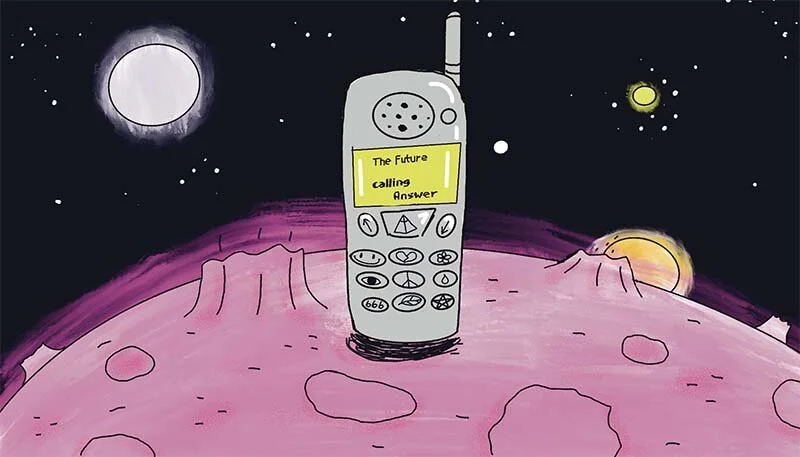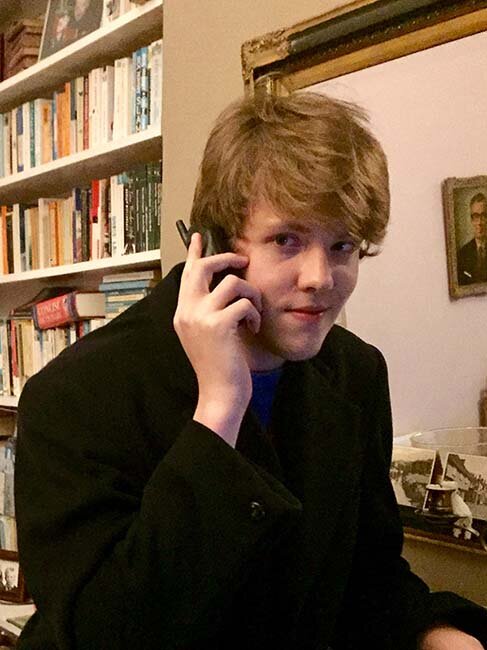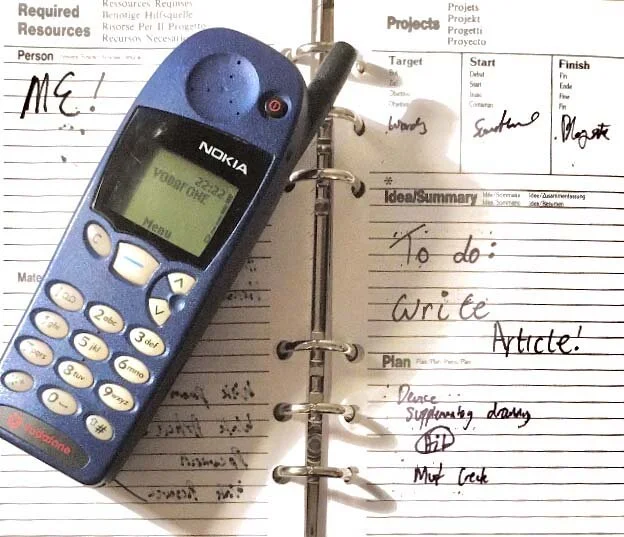The Remarkable Benefits of Using an Old Cell Phone — From Someone Who Still Has One
An 18-year-old explains why he prefers using a vintage Nokia, even though it’s older than he is.
By James Buckley
(Art: Megan Liscomb)
Whenever I pull out my cell phone, people laugh. It happens a lot. I watch as their faces shift from disbelief to shock to baffled amusement, particularly when they see the antenna.
It makes sense. For the last four years, I’ve been using a vintage Nokia cell phone— a technological relic so out-dated, you’re more likely to see it in a museum than in somebody’s hand. Pretty much nobody uses them nowadays, and, in fact, I wasn’t even alive when it was first made.
Known as the Nokia 5110, it was first released in 1998 and quickly became popular with younger generations because of its removable cases that came in different colors and patterns. It marked the first time Nokia made a mobile phone for consumers, shifting away from the company’s previous focus on business phones which had conference calling and faxing capabilities.
By the turn of the century, thanks largely to the Nokia 5110, the company’s profits hit $4 billion — more than $3 billion more than its earnings in 1995. Nokia’s sales skyrocketed a few years later when it introduced the Nokia 1100 in 2003 and the Nokia 1110 in 2005. The water- and dust-resistant phones were praised for their durability and became widely used in developing nations across Asia and Africa.
But it all went downhill for Nokia when Apple launched the first iPhone in 2007. For the Finnish-based firm, it became a sort of do-or-die ultimatum. Should it adapt its devices to have a touchscreen, or should it stay faithful to the buttons and screens that had earned it so much money over the years?
Nokia chose the latter, and this immediately set about killing the company. Though it released a handful of touchscreen devices a few years later, all have paled in comparison to the iPhone.
That’s not to say that Nokia was never innovative.
It released the Nokia 3650 in 2003, a phone that had a circular dial pad, boasting impressive features such as a camera, 2G internet access, and ringtones of popular songs. If you had the patience, you could even watch television from it. All you had to do was download an episode from the internet on your computer then transfer it to your phone through a cable.
Another innovative Nokia creation was the N-Gage, Nokia’s famed take on the Nintendo Game Boy. Launched in 2002, you could play 55 different games on it. Notable examples included a version of Tony Hawk’s Pro Skater and FIFA Soccer 2003, but you had to remove the phone’s battery and outer case to put the cards in. The Nokia N-Gage also had to be held sideways to take a call, earning it in the nickname of “The Taco Phone.”
The author taking a call on his old Nokia. (Photo: JB)
My Nokia 5110 was one of the last to be produced, made in March of 2000. It was also the final Nokia model ever to have an antenna.
I started using it because I hated the way my iPhone kept beeping at me. I felt constantly badgered by notifications of new emails to check, Facebook comments to laugh at, and “likes” on Instagram photos I’d posted.
My first cell phone — an iPhone 4 from 2010 — was a hand-me-down from my dad, which I got in 2015 as a 13th birthday present. In addition to using it for sending texts and making calls, I’d play Fruit Ninja with it on the bus to and from school and I kept up with my peers through the social media apps I downloaded.
Most nights, I’d tap away on my iPhone before going to sleep at some point around 3 a.m. When I’d wake up, it would be right there, charging on my bedside table and staring me in the face. It was my rock, but also my prison.
Four years ago I didn’t particularly mind the incessant notifications too much. But then I started studying for my General Certificates of Secondary Education and the incessant pinging really started to irritate me. Here I was, trying to cram for one of the most important tests of my life, and I was being bombarded with nonsense updates that served only to distract and annoy me.
I know I could have turned it off or silenced it, but that would only have provided a temporary refuge from the onslaught of noises. I also could have unsubscribed from everything, deactivated the most offending social media sites, and just gotten on with it. But I didn’t do that.
Instead, I decided to get a cell phone that was older and simpler — one so prehistoric, it didn’t have internet or even a color screen.
I bought my Nokia 5110 for a mere 50 pence at a car-boot sale in my city. I don’t know why it was so cheap — they sell for around £25-£30 (or $34-$40) on eBay — but at only 50 pence (or $0.68), I figured why not? It’s had a couple of upgrades over the years — a faster charger, a bigger battery, and a new blue front cover — but other than that, it’s worked just fine.
The author purchased his Nokia 5110 for a mere 50 pence…and it still works! (JB)
It was difficult to get used to at first. Because I felt like I was missing out on social media, I used to carry around both my Nokia and my iPhone to satisfy my FOMO urges. Eventually, I stopped using the iPhone altogether and started using social media only on my laptop.
Granted, the Nokia 5110 is annoying to use. For example: I have to push the “7” key four times to get an “S.” Remember, it was made in the days before predictive text.
Also, it’s quite bulky. It’s the size of a landline phone and the antenna stabs me in the leg on the rare occasion when I shove the device in my pocket (which it can barely fit in). Then again, on the plus side, I never have to charge it because the battery lasts for a week.
My vintage cell phone works in 2020 because the United Kingdom has not turned off the 2G networks that this archaic device relies on, which are also utilized by many car emergency systems. Most parts of Europe, Africa, Central America, and South America continue to utilize 2G, as well, however in the United States, Australia, and Japan 2G technology is in the process of being phased out so as to free up radio bands for newer technologies.
I pay £5/$6.80 per month for 150 minutes and 250 texts. But it’s a pay-as-you-go SIM card, which means it’s cheaper for me. If I had an iPhone, I’d probably be paying around £30/$40 per month for unlimited everything. My plan also comes with 250 megabytes of data...that I cannot use. Why? Because the Nokia 5110 has no data. Anywhere. Want to check your Facebook? Tough. Need an Uber? Good luck. There is no option for internet on this thing, which is both irritating or liberating depending on your perspective.
Though this didn’t motivate my decision to get an old mobile phone, I’ve since heard that some people opt for them because they’re difficult to track. Drug dealers, in particular, are said to be fond of them, with the 1999 Nokia 8210 being a particular favorite. According to VICE, old Nokias sell “straight away” whenever they come in stock at phone shops and some dealers will even trade drugs for their customers’ old phones.
The only differences between my Nokia 5110 and the aforementioned Nokia 8210 is the antenna (mine has one, the other does not), the size (mine is a lot larger), and the weight (mine is definitely heavier). My Nokia 5110 also has Snake, one of the most addictive games in the history of cell phones.
Old Nokias have even led to people being arrested. In 2002, a Brit named Thomas McKiddie tried to steal a Nokia 3310 (worth around £120/$163 at the time) so as to upgrade his old Nokia 3210 that came out in 1999. But while he was snatching the new phone, his older device fell out of his pocket at the crime scene. Police found it and used it to track him down, landing McKiddie behind bars.
"It was pretty stupid, I just lost my head,” McKiddie told Scotland’s Daily Record in 2002.
"I kicked in the glass door of the shop and took the new Nokia 3310 but I must have dropped my old phone and the police called Vodafone and found out who I was. I should have just upgraded it the normal way.”
What features would you miss most if you switched from a modern cell phone to a vintage one? (Photo: Flickr/Jack-Benny Persson)
Though there’s no technological practicality to using an old cell phone over a modern-day smartphone, they do help with muggings. In fact, as I’ve learned from experience, they’re pretty much theft-proof.
Not long ago, I was walking in the center of town on a dark and wet night when some bloke asked me for the time. I pulled out my phone to tell him and — he almost looked disappointed? Then he just walked away with not as much as a “thank you.” It was only later that I realized what he had been hoping to do.
But it’s not so much what the Nokia 5110 offers that appeals to me, so much as what it lacks. What I hate about Apple (and iPhones, in general) is how locked down it all is. Want to put an SD card into your iPhone? You can’t. You must pay for more storage or buy one of their subscription iCloud plans. Want to download an app that isn’t on the App Store? Unless you want to void your warranty and have the possibility of bricking your phone, don’t do it. You might get that lovely app, but you might also get a very expensive paperweight.
I’m evidently not alone in this mindset. A woman named Alice who lives in London told VICE she got rid of her iPhone three months ago and is now using HMD Global’s 8110. She based her decision on a multitude of interconnected factors, mainly relating to data privacy and the way apps monetize our attention.
“Your smartphone is like a secret diary, but it’s uploaded onto the Cloud and sold to advertisers,” she told the news outlet. “We're not dealing with platforms that have our best interests at heart. These are capitalist entities; they have their business at heart. We can’t expect them to turn into saints. So we have to change the way we behave around technology.”
She also said that since switching to an old cell phone, she’s felt more free, present, and safe because now her device isn’t using her personal details to constantly sell her products.
Remi, a 25-year-old student from Manchester, told VICE she just wanted to get a break from her smartphone when she switched to an old-school model a few years ago.
“I bought the baby blue Nokia 3310 when it came out because I liked the look of it and it matched my puffa. I thought I could bring it to festivals or on holiday,” she said.
“But then I carried on using it when I got back from Glastonbury this year. While I was away I realized just how much I had been checking Insta[gram] and all these apps. It felt good to get a break from that. I thought, ‘Why not continue that break?’ I don’t need to constantly be glancing at my phone when I could be getting on with stuff that benefits me.”
At the end of the day, though, are old mobiles really worth anything? Sentimentally, they are priceless. But in terms of currency, probably not. Unless you’ve got one lurking in your bedroom drawers, that is. The original Nokia 8110 from 1997 can go for as much as $500 new, but it’s worth only around $55 used.
As much as I wish I could use it forever, I know that one day my Nokia’s little silicon heart will stop beating. Maybe it will be the deactivation of the U.K.’s 2G networks that kills it (this is rumored to happen in the late 2030s). Maybe the lithium-ion battery will no longer take a charge. Or maybe it will just die for no clear reason.
At that point, I’ll have to consider whether I’m ready — and willing — to rejoin the smartphone world. But until that day comes, I’ll continue using my archaic cell phone as I do now: for making phone calls, sending text messages, opening beer bottles, and getting laughs.

















